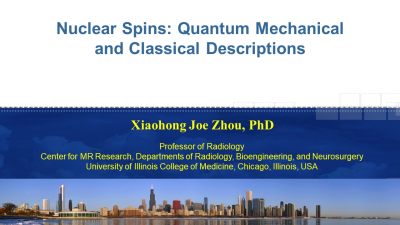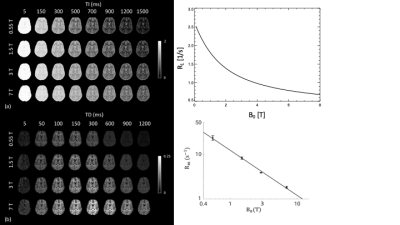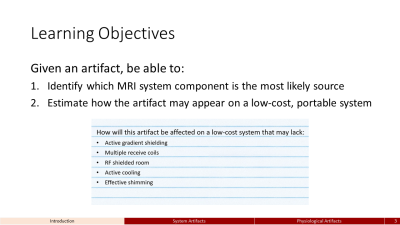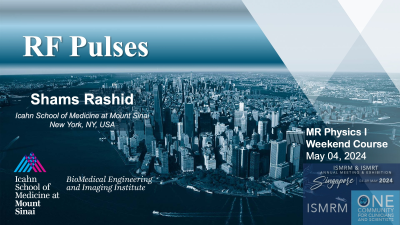Weekend Course
MR Physics I
ISMRM & ISMRT Annual Meeting & Exhibition • 04-09 May 2024 • Singapore

| 08:00 |
 |
Nuclear Spins: Quantum Mechanical & Classical Descriptions
Xiaohong Joe Zhou
Keywords: Physics & Engineering: Physics Magnetic resonance (MR) is a phenomenon observed in nuclei that possess nonzero spins (i.e., nuclei with both magnetic moment and angular momentum). These nuclei can be found naturally in the human body (e.g., 1H, 13C, 23Na, and 31P) or introduced as an exogenous agent (e.g., 3He and 129Xe). This lecture will use both quantum mechanical and classical approaches to describe how nuclear spins, through interactions with static and radiofrequency magnetic fields, generate bulk magnetizations and electrical signals. Several MR concepts, such as the Larmor equation and Bloch equations, will also be introduced to pave the way for the subsequent lectures. |
| 08:25 |
Bloch Equation & Relaxation
Analia Zwick
Keywords: Physics & Engineering: Physics In this talk, we explore the foundational principles of magnetic resonance imaging (MRI), rooted in quantum physics and the Bloch equations governing nuclear spin dynamics in a magnetic field. We analyze key relaxation mechanisms such as T1 and T2 relaxation, crucial for MRI signal acquisition and contrast generation. Join me to learn these concepts, essential for enhancing MRI scan quality and diagnostic accuracy. |
|
| 08:50 |
 |
Field-Dependent Contrast Mechanisms
Peter van Gelderen
Keywords: Physics & Engineering: Physics, Contrast mechanisms: Relaxometry The utility of MRI depends on the information carried by the contrast between different tissue types. This contrast can stem from MR-independent properties, like proton density, water diffusion or magnetic susceptibility, but is typically based on MR relaxation parameters, T1, T2 or T2*. All of these depend on the field strength. To compare data acquired at different fields, some understanding of these dependencies is necessary. In this presentation, the basic physics of relaxation mechanisms and their field dependence will be discussed. In addition, example data on relaxation measurements in brain imaging at various field strengths will be presented. |
| 09:15 |
Break & Meet the Teachers |
|
| 09:40 |
 |
Signal & Noise Considerations Across B0s
Lawrence Wald
Keywords: Physics & Engineering: Physics The signal-to-noise ratio is one of the most important determinants of our ability to extract information from a measurement in that it expresses the signal measurement’s relative uncertainty. Improving it is a frequent target of technical development and SNR is constantly monitored as a quality assessment. This seemingly simple ratio of the signal level to its uncertainty or “noise” level, would appear a simple and well-defined metric but is more difficult to measure than one would think and it is critical to understand how each component (signal and noise) is modulated by experimental parameters. |
| 10:05 |
Extended Phase Graphs
Matthias Weigel
Keywords: Physics & Engineering: Physics, Image acquisition: Sequences, Physics & Engineering: Nuclear Magnetic Resonance The Extended Phase Graph (EPG) concept represents a powerful tool for depicting and understanding magnetization response of several MRI and MRS sequences. It allows pictorial understanding of echo generation, simple but elegant classification of echoes, and at the same time fast and accurate computation of echo intensities. It particularly demonstrates its advantages in the application for NMR sequences with multiple gradients and RF pulses. Motion effects (rigid body motion, flow, free diffusion) can also be considered. Overall, the EPG concept is really worth studying to get a deeper insight into the understanding and development of complex NMR sequences. |
|
| 10:30 |
 |
Artifacts & Their Subtleties Across Magnetic Field Strengths
Philip Lee
Keywords: Physics & Engineering: Physics, Image acquisition: Artefacts Image artifacts are common in MR imaging due to system imperfections, physiological considerations,and imaging parameter selection. In this session, we will view common artifacts that would be encountered in clinical MRI, and discuss how they may manifest at different field strengths, as well as in low-cost portable MR systems. At the end of this session, an audience member should be able to identify common image artifacts, and be able to reason about which hardware component: main magnetic field, gradient, receive coil, or RF transmit, is the most likely contributor. |
| 10:55 |
 |
RF Pulses
Shams Rashid
Keywords: Physics & Engineering: Physics, Physics & Engineering: RF Safety Imaging with MR begins with one or more radiofrequency (RF) pulses, making them a key component of any MRI pulse sequence. This lecture will review the fundamentals of RF pulses in MRI, including hard pulses vs. soft pulses, sinc pulses, slice/magnetization profiles, the small-tip angle approximation, RF bandwidth and the time-bandwidth product. Similarities and differences among excitation, inversion and refocusing pulses will be emphasized. The lecture will conclude with a discussion of advanced topics such as the Shinnar-Le Roux (SLR) algorithm for RF pulse design and adiabatic pulses, highlighting the need for these types of pulses and their applications. |
| 11:20 |
Meet the Teachers |
The International Society for Magnetic Resonance in Medicine is accredited by the Accreditation Council for Continuing Medical Education to provide continuing medical education for physicians.